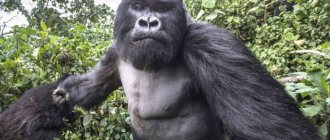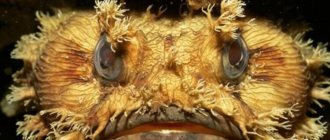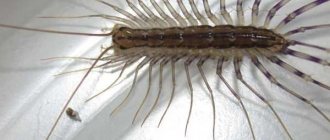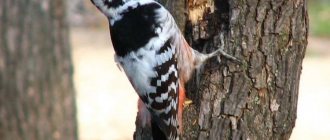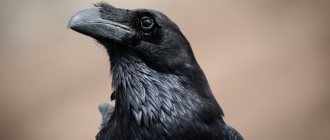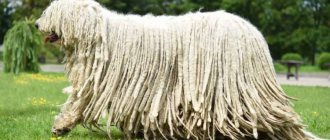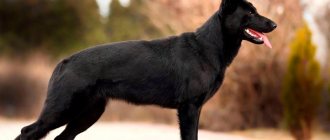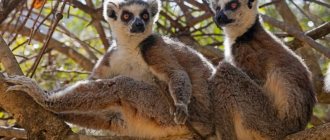Features of the appearance of small galagos
The small southern galago is approximately the same size as a small squirrel: it reaches a length of 15-16.8 centimeters, plus a tail length of 11-28 centimeters.
Females weigh about 1.4-2.3 kilograms, and males - 1.6-2.5 kilograms. The fur is dense and soft. The upper part of the body is gray, and the lower part is gray-yellow. There are yellow markings on the abdomen and legs. The head is decorated with a dark eye mask. There are no visual sexual differences between males and females.
The shape of the lower incisors has the appearance of a toothed comb; such teeth are good for cleaning fur. Lesser southern galagos have large ears and large orange eyes.
Southern little galago (Galago moholi).
Lifestyle of southern galagos
These primates lead a semi-terrestrial and semi-arboreal lifestyle. They are active at night, and during the day they sleep in nests, which they make in hollows or hollow trees, and they can also rest in abandoned bird nests. The galago family is housed in one large nest, and individuals lie in different corners of it, sometimes with their bellies upside down. In this position, the hind legs cover the head, and the entire body is covered by the tail. Galagos sleep very soundly; it takes 1-2 minutes for the animal to wake up, so they are very vulnerable during sleep.
Southern small galagos can live not only in small family groups, but also alone. The family consists of a female and her offspring. Adult male galagos most often exhibit territorial behavior and mark their territory, the boundaries of which intersect with the boundaries of several females. Males do not allow other males into their territory.
Southern galagos inhabit savannas, woodlands, gallery forests, and forest edges.
Olfactory communication plays an important role in the nocturnal life of small galagos. They use their own urine as a marker. The males wet their paws in urine and leave their mark on all the trees along which they move, this is how they mark their territory. Females also show signs of olfactory communication, using urine to inform males that they are ready to mate.
With tactile communication, when individuals sniff each other's noses, sex is determined and friendly relations are established. There is practically no social care between individuals.
Southern galagos are omnivores, but their carnivory is more pronounced. They mainly feed on arthropods, but also eat plant foods. Their diet consists of beetles, grasshoppers, butterflies, caterpillars, seeds, fruits and flowers. Galagos especially like tree gum.
A group of small galagos usually consists of a female and her offspring.
Slow loris - bug-eyed monkeys
Some might think that "slow loris" is a very appropriate nickname for a clumsy eater.
But in fact, this is the name of a species of animal belonging to one of the five species of funny creatures with large eyes that are part of the loris family. In countries where English is spoken, it is also called "slow" due to the fact that it moves very smoothly.
The Latin name for slow lorises is Nycticebus. They live in eastern Bangladesh, northeastern India and the warm Indonesian islands in Indochina.
They are often quite unreasonably confused with lemurs. These animals are distinguished from each other by many characteristics, in particular the fact that lemurs live at a great distance from lorises - in Madagascar.
Slow loris (Nycticebus).
Another difference is that slow lorises, like other members of this family, lack a tail. More precisely, it is there, but of such a small size that it can only be detected by feeling the animal. These are small animals, whose body length can be from 18 to 38 cm, and their weight is no more than one and a half kilograms. Slow lorises are one of the few representatives of this family that survive in captivity.
But before you get yourself such a pet, you need to take into account the fact that there are five species in the genus of slow loris, and one of them, or rather the small slow loris, is poisonous. This tiny creature, only 18-20 cm in length with innocent eyes, can cause a lot of trouble. The fact is that on the elbow of this representative of the loris family there are glands that are capable of secreting a substance that, when mixed with saliva, becomes a potent poison.
Slow lorises are funny and cute monkeys.
In the wild, small lorises use this poison to protect their cubs from predators. To do this, they lick the baby's fur, which after such treatment becomes poisonous. The bites of these animals are also poisonous, since the elbow glands often come into contact with saliva.
Lori enjoys a sweet banana.
And other types of slow lorises are absolutely harmless. They lead an active lifestyle at night, which explains the presence of such large eyes. Most often they live alone, sometimes in pairs or groups that are not created for a long time. As a rule, several females live in the area of one male. A female, ready for fertilization, attracts a male with her urine, in which special pheromones appear during this period.
Females carry their cubs for about three months. As a result, one baby is born. Immediately after birth, the cub clings to the mother's fur and spends the next two weeks in this state. And although just a day after birth he gains the ability to cling to tree branches, he still prefers to be near his mother’s nipple.
In the wild, male loris do not take part in raising their offspring, while in captivity some caring fathers simply take the cub away from the mother and protect it themselves and carry it on themselves, giving it to the mother only to feed it.
A curious small animal - the loris.
The main food products of lorises are insects, bird eggs, chicks and their small parents, various rodents, as well as nectar and fruits. They are peaceful and do not come into conflict with each other in the process of obtaining food. Most often, “neighbors” demonstrate different poses when they meet, or brush each other’s fur. For this procedure, the thick loris has a special tool - the so-called “cosmetic” claw, which is located on the second toe, and on all other fingers they have ordinary nails.
The slow loris is an excellent tree climber.
One can only regret that these extraordinary animals are under threat of complete extinction. They live in tropical forests that are constantly being cut down. We can only hope that humanity will be able to stop in time and save both the tropical forests and their inhabitants.
https://www.youtube.com/watch?v=8Uz103d7Ow4
If you find an error, please select a piece of text and press Ctrl+Enter.
Reproduction of southern galagos
Female galagos are capable of giving birth to babies every 4-8 months. There is no seasonality of reproduction. Males, as a rule, mate with all females that are in their area and ready to mate.
Pregnancy lasts about 123 days, after which 1-2 babies are born. The female galago gives birth to babies in a specially equipped nest, which can be located in a hollow or on a branch. In the first pregnancy, most often one baby is born, and then mostly twins.
Females of southern galagos build nests where they give birth and raise their offspring in the first days of life.
Newborn galagos weigh 10.6 grams. When the mother feeds, the baby sits quietly in the nest, waiting for her to arrive. If the female decides that the nest is in danger, then she changes its location, for this she takes the baby in her teeth and carries it to a new nest. So the mother can carry the baby until the age of 50 days. At 2 weeks the baby can take short walks, and at one month he is able to eat adult food; at 3.5 months he begins to lead an independent life. Sexual maturity in southern galagos occurs at 9-12 months.
Prospects for the conservation of the southern galago population
Southern galagos are kept in zoos and are sometimes kept as pets.
Southern galagos make excellent pets.
These are very fast animals, so they are difficult to catch. If the galago is frightened, it bites, even when living for a long time in captivity.
These small primates have been successfully bred in captivity, raising promising hopes for the conservation of the species. In captivity, they can live a maximum of 16 years. Their natural enemies are many feathered and terrestrial predators.
If you find an error, please select a piece of text and press Ctrl+Enter.
Top 25: rare species of primates that could disappear from the face of the Earth in the next hundred years
Primates are increasingly becoming animals facing extinction. With increasing levels of deforestation (deforestation), the amount of agricultural land and due to brutal poaching, over the past few decades, the population of many representatives of this progressive order has decreased extremely significantly. Without proper conservation measures, we could see mass extinction of these fascinating creatures over the coming decades. Primates are an important part of many ecosystems around the world, playing an important role in their prosperity and recovery. They are also very important to many cultures and religions and allow us to study evolutionary processes. The disappearance of these species could be a real disaster for the entire planet. Are you ready to find out which animals we could lose very soon and forever? Here is a selection of 25 species of primates that are in mortal danger if we don't stop exterminating them.
25. Red-crested colobus from the Tana River (Procolobus rufomitratus)
Photo: Olivier Lejade/France
These monkeys live on the coast of the Kenyan Tana River, and from 1975 to the present day their numbers have declined to about 1,300 individuals, the main reason for which has been active deforestation. Thanks to the measures taken, the species' numbers are recovering, but it is still in danger of extinction.
24. Sumatran orangutan (Pongo abelii)
Photo: Aiwok
Due to severe deforestation of the rain forests in Sumatra, the population of local orangutans has dropped to 14,600 individuals, making the species quite rare. In addition, these animals are easy targets for poachers, making it even more vulnerable to extinction.
23. Western river gorilla (Gorilla gorilla diehli)
Photo: arenddehaas / English Wikipedia
This is one of the four species of gorillas, and it is recognized as one of the rarest, since according to the latest data there are only 300 of its representatives left in the world. The main threats are deforestation and poaching. However, some researchers believe that the western river gorilla has a chance of survival in a natural park on the Cameroon-Nigerian border, where these primates can feel safe and eventually restore their numbers.
22. Tonkinese rhinopithecus (Rhinopithecus avunculus)
Photo: Quyet Le
As usual, there are fewer and fewer forests, and more and more hunters... This monkey is in great danger - in Vietnam, where it comes from, there are only 113 Tonkinese rhinopithecus left, and there are only about 250 individuals of these monkeys in the world. There is still hope for the preservation of the species, but it is extremely shaky.
21. Gentle lemur of the species Hapalemur alaotrensis
Photo: Mark Kent
Endemic to Madagascar, this lemur lives in both rain forests and swamps, but the population of the species is declining literally every day. Since 2008, Hapalemur alaotrensis has received alarming status as a critically endangered species, with only 2,500 individuals found in the wild.
20. Red-crested colobus from Bioko Island (P. pennantii pennantii)
Photo: Atamari
These primates live only on the island of Bioko (Equatorial Guinea), and from 1986 to 2006 their population declined by as much as 45%. Now scientists count about 5,000 individuals, and their number is rapidly falling.
19. Simias concolor
Photo: Pinterest.com
Living in swampy areas and lowlands of rain forests, the monochromatic simias may very soon be left without a home. In just 10 years, the number of individuals of this primate species has decreased by up to 90%, so it is in great need of our protection.
18. Pygathrix cinerea
Photo: Chi King
A unique inhabitant of Vietnam, this animal is in great danger, because its population has now decreased by as much as 80%, and researchers believe that in the coming years there will be even fewer of these cute creatures. According to experts, there are only 550 seroplus pygatrixes left in the world.
17. Siau Island Tarsier (Tarsius tumpara)
Photo: Ariefrahman
On the verge of extinction, the tarsier from Siau Island (Siau, Indonesia) may very soon disappear from the face of the Earth. Over the past three generations, the species' population size has decreased by 80%. According to various sources, there are now between 1,358 and 12,470 such primates left in the world.
16. Black lion marmoset or golden-rumped marmoset (Leontopithecus chrysopygus)
Photo: Alan Hill
This amazing animal lives in the rain forests of Brazil, and since 2003 it has been listed as an endangered species. Scientists estimate that there are about 1,000 representatives of this rare species left in the wild, and in recent years there has been a clear decline in its numbers.
15. White-rumped Gulman (Trachypithecus delacuri)
Photo: Olevy
These primates live in north-central Vietnam in a very rocky and wooded area. Since 1996, the population has been rapidly declining, and according to the latest data, no more than 250 individuals of this species now exist in nature.
14. Western red-faced goulman (Semnopithecus vetulus nestor)
Photo: Jeroen84
Endemic to Sri Lanka, the Western Red-faced Gulman has become 50% less common over the past 36 years. Researchers believe that the numbers of this species will continue to decline at the same rate over the next three generations. The reasons are the same - destruction of natural habitats and poaching.
13. Golden-headed or white-headed gulman (Trachypithecus poliocephalus)
Photo: shutterstock
In 1996, this primate had the status of an endangered species, and already in 2000 it was listed as a species on the verge of complete extinction. As of 2006, the golden-headed gulman population numbered approximately 864 individuals, including an additional 64 subspecies. Unfortunately, this amazing animal may disappear from the face of the Earth due to poaching.
12. Rungwecebus kipunji
Photo: wikipedia.commons.com
For a long time, monkeys of the species Rungwecebus kipunji were considered a local legend or cult creature from the beliefs of Tanzanians. However, in 2003, scientists still discovered real representatives of this species. Unfortunately, that same year, these primates were immediately placed on the list of endangered animals. According to experts, no more than 1,000 such individuals now live in nature.
11. Colombian coata (Ateles hybridus)
Photo: https://www.birdphotos.com, processed by Fir0002
These primates are among the rarest animals in the whole world. Such exotic spider monkeys are found only on the right bank of the Magdalena River and in the southwest of the Guajira Peninsula, Colombia. Over the past 45 years (about 3 generations), the population has decreased by 80%. The exact number of surviving Colombian koatas is currently unknown, although 98% of their original range has already been destroyed, so there is practically no place for them to breed.
10. Cercopithecus roloway
Photo: Hans Hillewaert
This species is found primarily in Ghana and its population has now declined by 50%. According to a 2007 study, the primate Cercopithecus roloway is on the verge of extinction or even completely extinct.
9. Blue-eyed lemur (Eulemur flavifrons)
Photo: Clement Bardot
Since 2011, these lemurs have been listed as critically endangered. The rare animal lives only in Madagascar, but constant deforestation and active poaching have caused serious damage to its population. In the coming decades, we may finally lose this handsome man...
8. Northern slender-bodied lemur (Lepilemur septentrionalis)
Photo: Leonora (Ellie) Enking
If in 2000 these lemurs were considered a vulnerable species, then already in 2008 they moved into the category of animals on the verge of complete extinction. Only 50 individuals exist on the planet at the moment, and this number will most likely only decrease...
7. Horton Plains red loris (L. tardigradus nycticeboides)
Photo: Alex Pyron
This primate is such a rare animal that scientists thought the unique species was completely extinct until they rediscovered it in 2002. Representatives of the Zoological Society of London confirmed a second encounter with this animal in 2009 in the Horton Plains National Park, Sri Lanka. There are probably less than a hundred of these lorises in the wild now.
6. Lemurs of the species Propithecus candidus
Photo: wikipedia.commons.com
Endemic to Madagascar, these rare lemurs are increasingly rare on the island. Since 1996, they have been recognized as animals on the verge of extinction, since no more than 250 individuals are known to exist in nature.
5. Gibbon species Nomascus hainanus
Photo: Benjamin Radzun / flickr
Over the past 45 years, the population of this primate has decreased by 80%, and it is increasingly heading towards complete extinction. In 2003, researchers knew of the last 20 Nomascus hainanus gibbons on the entire planet...
4. Red vary (Varecia rubra)
Photo: wikipedia.commons.com
This unusual animal also lives only on the island of Madagascar, and in 2009, due to the destruction of its natural habitat, it also received the status of a species on the verge of extinction.
3. Brown-headed or black-fronted koata (Ateles fusciceps)
Photo: Petruss
Like many of the other primates on this list, brown-headed coats are critically endangered, having declined by 80% in the last 45 years. Ateles fusciceps are still found in Colombia, Panama and Ecuador, although they are extremely difficult to see in the wild.
2. Northern brown howler (Alouatta guariba guariba)
Photo: Kenny Ross
Here is another amazing primate, and again this is a rather rare subspecies. The northern brown howler lives in the rain forests of Brazil and is considered the largest South American herbivore. Unfortunately, according to the latest estimates, there are about 250 individuals of these creatures left in the wild and no more.
1. Capuchin kaapori (Cebus kaapori)
Photo: Whaldener Endo, processing: Diliff
Well, our sad list ends with the capuchin-kaapori, whose population has also decreased by 80% over the past 43 years. Of all the Amazon primates, this species is the most vulnerable and rare. The security status is “critically endangered”.
